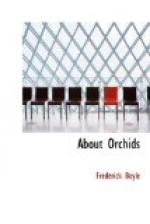Epidendrums mostly will bear as much heat as can be given them while growing; all demand more sunshine than they can get in our climate. Amateurs do not seem to be so well acquainted with the grand things of this genus as they should be. They distrust all imported Epidendrums. Many worthless species, indeed, bear a perplexing resemblance to the finest; so much so, that the most observant of authorities would not think of buying at the auction-room unless he had confidence enough in the seller’s honesty to accept his description of a “lot.” Gloriously beautiful, however, are some of those rarely met with; easy to cultivate also, in a sunny place, and not dear. Epid. rhizophorum has been lately rechristened Epid. radicans—a name which might be confined to the Mexican variety. For the plant recurs in Brazil, practically the same, but with a certain difference. The former grows on shrubs, a true epiphyte; the latter has its bottom roots in the soil, at foot of the tallest trees, and runs up to the very summit, perhaps a hundred and fifty feet. The flowers also show a distinction, but in effect they are brilliant orange-red, the lip yellow, edged with scarlet. Forty or fifty of them hanging in a cluster from the top of the raceme make a show to remember. Mr. Watson “saw a plant a few years ago, that bore eighty-six heads of flowers!” They last for three months. Epid. prismatocarpum, also, is a lovely thing, with narrow dagger-like sepals and petals, creamy-yellow, spotted black, lip mauve or violet, edged with pale yellow.
Of the many hot Dendrobiums, Australia supplies a good proportion. There is D. bigibbum, of course, too well known for description; it dwells on the small islands in Torres Straits. This species flowered at Kew so early as 1824, but the plant died. Messrs. Loddiges, of Hackney, re-introduced it thirty years later. D. Johannis, from Queensland, brown and yellow, streaked with orange, the flowers curiously twisted. D. superbiens, from Torres Straits, rosy purple, edged with white, lip crimson. Handsomest of all by far is D. phaloenopsis. It throws out a long, slender spike from the tip of the pseudo-bulb, bearing six or more flowers, three inches across. The sepals are lance-shaped, and the petals, twice as broad, rosy-lilac, with veins of darker tint; the lip, arched over by its side lobes, crimson-lake in the throat, paler and striped at the mouth. It was first sent home by Mr. Forbes, of Kew Gardens, from Timor Lauet, in 1880. But Mr. Fitzgerald had made drawings of a species substantially the same, some years before, from a plant he discovered on the property of Captain Bloomfield, Balmain, in Queensland, nearly a thousand miles south of Timor. Mr. Sander caused search to be made, and he has introduced Mr. Fitzgerald’s variety under the name of D. ph. Statterianum. It is smaller than the type, and crimson instead of lilac.
Bulbophyllums rank among the marvels of nature. It is a point comparatively trivial that this genus includes the largest of orchids and, perhaps, the smallest.




